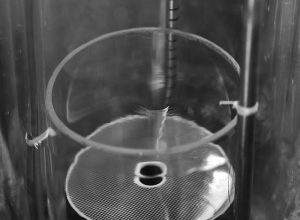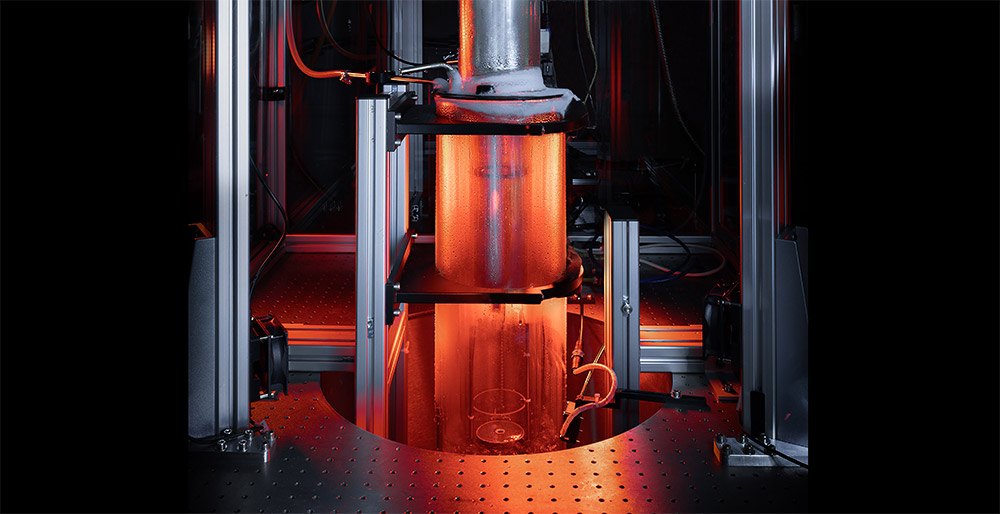Space-time in the lab: Physicists have created a 'quantum tornado' of liquid helium for the first time – a vortex of superfluid liquid that can replicate the behavior of space-time. Thus, this quantum tornado could reveal how rotating black holes distort space-time and its quantum structure in their surroundings. The superfluid helium vortex exhibits physical properties similar to those found in a black hole's massive gravitational field, the team reports in the journal Nature.
Albert Einstein realized that objects with large masses can bend space-time and even deflect rays of light. This effect is even more extreme in the case of a black hole: its gravitational pull is so intense that it creates a funnel in space-time that opens downward, perhaps even a wormhole to other parts of the universe. But how space-time behaves in this funnel and how it changes as the black hole rotates has so far only been partially and theoretically explained.
Warped space-time in the laboratory
That's why physicists are looking for ways to recreate space-time and its properties in the laboratory, for example using so-called gravity simulations. “These are laboratory systems in which small excitations such as sound or surface waves behave like fields propagating in the curved geometry of space-time,” explain Patrick Ivankara of the University of Nottingham and his colleagues. The first approximate analogues of this type have already been carried out using ultracold atomic clouds and liquid helium.
“But in order to experimentally recreate the curved spacetime of a black hole, you need a specific relative motion between these excitations and the carrier medium,” physicists say. Simulations have shown that these conditions can be achieved using extended vortices in ultracold, liquid helium. But there is a lack of implementation so far. “Ultrafluid helium has small quantum vortices that tend to diverge,” Ivankara explains. Confining them and continuing to create a stable “tornado” proved difficult.
A swirl of superfluid helium
Now the team around Vankara has achieved this. For the first time, they have created a microscopic rotating vortex in superfluid helium that resembles spacetime curved around a black hole in basic shape and features. This was achieved in a cylindrical glass tank in which several liters of helium-4 were cooled to 1.92 K, less than two degrees above absolute zero. A fan and special flow adjusters at the bottom of the tank caused the supercooled liquid to circulate.

Successfully: “In our experiment, we were able to confine tens of thousands of small quantum vortices into a compact shape resembling a mini-tornado,” Ivankara reports. “In this way, we achieved an eddy current of record strength for quantum liquids.” The team describes the resulting vortex as a “quantum hurricane.”
Effects such as a black hole
But crucially, the quantum hurricane made of liquid helium shows exactly the wave patterns and substructures that theoretical models also predict for the space-time around black holes. “Key processes in the rotation of curved space-time, such as superradiation and the black hole oscillation pattern, can be explored in our system with only minor modifications to the fan speed, reservoir geometry, or flow parameters,” the physicists wrote.
According to Vankara and his team, their quantum tornado opens up entirely new opportunities to better explore the complex nature of space-time and its interaction with gravity. “In our experience, we have taken this research to the next level,” says lead author Silke Weinfurtner from the University of Nottingham. “This may allow us to predict the behavior of quantum fields in curved spacetime around astrophysical black holes.” (Nature, 2024; doi: 10.1038/s41586-024-07176-8)
Source: University of Nottingham
April 3, 2024 – Nadia Podbrigar

“Social media evangelist. Baconaholic. Devoted reader. Twitter scholar. Avid coffee trailblazer.”







More Stories
Is the First Descendant a technical glitch? Tech experts highlight performance issues and more
These brands are most vulnerable to phishing scams
Apple Maps Now Has a Web Version and Wants to Challenge Google Maps